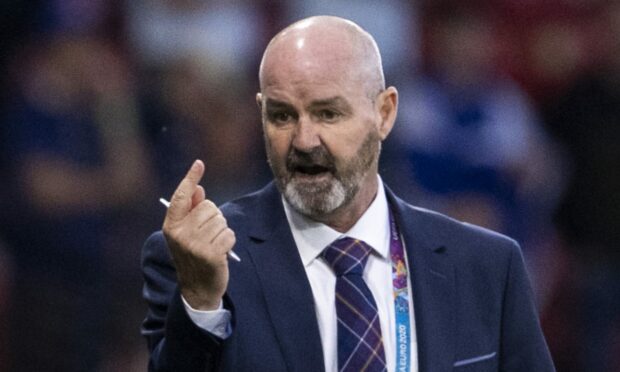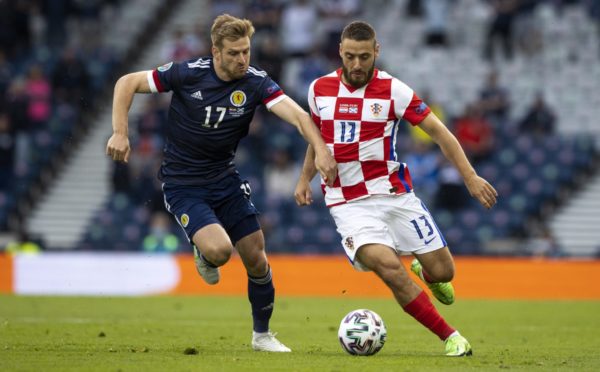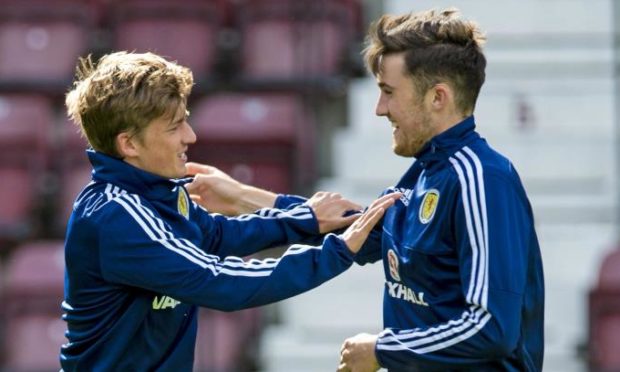A group stage tournament exit post-mortem is nothing new as far as the Scotland national team is concerned, albeit it’s been a while since there has been the need for one.
Eric Nicolson assesses five talking points arising from this Euro 2020 campaign and looks to a (hopefully) promising future.
1 Can do better applies to Steve Clarke as well as his team
“We’ll all learn from it.”
Steve Clarke is a man of few words but those are very important ones.
As a three-game whole, the Scotland team fell below the standards we expected of them at Euro 2020.
Not hugely, but enough to make us look like the fourth-ranked team in the group that we were.
And Clarke also probably under-performed.
Selection is everything in tournament football and he got his wrong in the opening game against the Czech Republic, which was the one Scotland needed to win.
He put his faith in Billy Gilmour a match too late and preferring Lyndon Dykes to Che Adams was also a mistake.
Clarke picked the correct line-up at Wembley and I can understand why he opted for Stuart Armstrong to replace the Chelsea youngster on Tuesday night.
There were no other Billy Gilmour types to turn to. John Fleck out of nowhere would have been far too big a gamble.
'We want to go again, we want to get those supporters back, they were tremendous again tonight.'
Steve Clarke hailed the backing of the Tartan Army after Scotland exited Euro 2020. https://t.co/3EtTlYU2fN pic.twitter.com/4kdbdRGBWN
— STV Sport (@STVSport) June 22, 2021
I suspect folk picking over the bones of his starting elevens will be neither here nor there for Clarke.
The observation of Graeme Souness that Scotland played “football from a different era” will surely penetrate even the thickest of skin, however.
Souness was a bit over the top.
Yes, there was a misguided tactical approach in the Czech Republic contest.
And yes, the Scots did become overly reliant on long balls up to Lyndon Dykes against Croatia as well.
But the defenders would have recognised what happened when they tried playing through Armstrong – possession was quickly turned over.
Without Gilmour, they simply didn’t have the quality in midfield to even attempt to match-up Croatia, and Luka Modric in particular, with a passing game.
I’ve got no issue with tactics being altered to suit an opponent – which Clarke did over the course of the three fixtures.
It was the execution of those tactics that fell short.
Had diagonal balls to a striker been married to lively forward play around Dykes and had there been more intense pressing across all areas of the pitch, Scotland would have done much better.
I still don’t think they would have won, though.
2 A team that has evolved
Tournament football is a brutal business, especially in a group like the one Scotland found itself in.
But for a team with room for improvement that is a good thing in the long-term.
Flaws that can be papered over in friendlies, championship qualifiers and the Nations League, are exposed at this level.
And the evolution of a side quickens if you allow it to.
Clarke can’t get in the way of that.
I’m not saying cast Armstrong and Stephen O’Donnell out of future squads, never to return, but they are short of the calibre required to progress Scotland to the standard of team that can reach the last 16 of a European Championship or World Cup.
It goes without saying that we will see a lot more of Gilmour but we also need to see a lot more of Nathan Patterson and David Turnbull.
3 Issues up front
To continue that accelerated evolution theme, it does feel as if Dykes is not keeping pace.
His very presence tempts defenders to go too long too often and the ball didn’t stick to him nearly as much as it needed to.
You can still see a role for him as a lone striker in qualifiers when the opposition is relatively weak but, given the rough edges that aren’t likely to be smoothed over, Scotland need to get themselves into a place where he is a potential impact sub against the top tier nations rather than a regular starter as he was in the Euros.
I was also a bit underwhelmed by Adams, mind you.
Che Adams goes close for Scotland after being put through by John McGinn.
Watch LIVE: https://t.co/rvaZapSXcz#SCOCRO #EURO2020 pic.twitter.com/5bn7ifL453
— STV Sport (@STVSport) June 22, 2021
More composure was expected of a regular scorer in the English Premier League.
Clarke needs him to come good when the World Cup campaign resumes and, in the absence of another elite centre-forward, the manager should deploy a number 10-type off him.
4 Perspective required
There have been plenty of occasions over the last three decades when the bigger picture of grassroots and professional age-group football have necessarily come under the microscope.
This is certainly not one of them.
The instinctive ‘if Croatia can do it with a smaller population then why can’t we’ argument is a red herring.
In almost every position bar centre-forward and goalkeeper, young players have either forced their way into the squad or are on the cusp of doing so.
Clarke needs to be a bit quicker and bolder in giving them their chance but the truly elite ones will always kick the door down.
That there is a core of ‘good age’ 20-plus capped regulars to help them integrate is essential and in Andy Robertson, Kieran Tierney, John McGinn and Scott McTominay, Scotland undoubtedly have those.
And, in Gilmour, they have a player of world class potential – arguably the first in that bracket since Dalglish and Souness in the 1980s – who you mould a style of play around.
Clarke has seen it work perfectly at Wembley and that should give him clarity of thought and selection as he moves forward.
The manager is still learning on the job, by his own admission.
But it is from a position of strength.
Clarke’s squad will be tweaked and enhanced, not gutted.
And Scotland’s academy structure is producing players who will continue to challenge his ingrained caution.
5 New faces
That building a team around Gilmour mindset should improve the chances of a Ryan Gauld call-up.
Here’s another player whose strengths are keeping the ball ticking over, being happy to accept it in the tightest of situations and never settling for a backward or sideways pass if there’s an opportunity for a forward one.
Gauld’s former Dundee United team-mate, John Souttar will surely be back if his fitness holds up on Hearts’ return to the Premiership and Aaron Hickey is worthy of squad selection as well.
If Jason Kerr excels in the Europa League qualifiers with St Johnstone, Clarke can’t continue to ignore him.
Filling the gap between the ageing goalkeepers and the very young ones is also a priority.
Zander Clark has earned an opportunity to do that but I wouldn’t be surprised if Clarke tries to persuade Angus Gunn to turn his back on England and make his dad, Bryan, happy.


